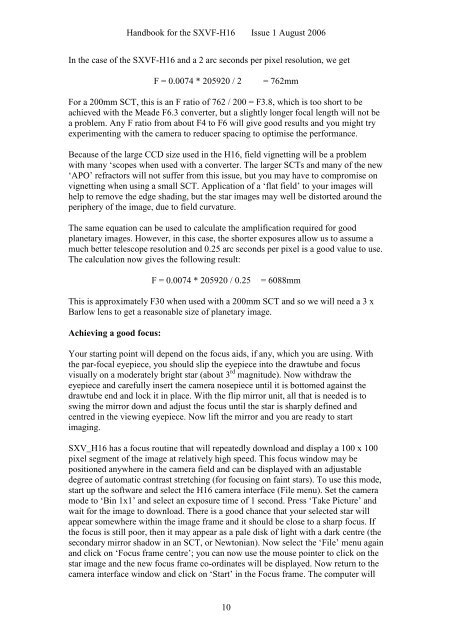SXVF-H16 handbook.pdf - Starlight Xpress
SXVF-H16 handbook.pdf - Starlight Xpress
SXVF-H16 handbook.pdf - Starlight Xpress
Create successful ePaper yourself
Turn your PDF publications into a flip-book with our unique Google optimized e-Paper software.
Handbook for the <strong>SXVF</strong>-<strong>H16</strong> Issue 1 August 2006<br />
In the case of the <strong>SXVF</strong>-<strong>H16</strong> and a 2 arc seconds per pixel resolution, we get<br />
F = 0.0074 * 205920 / 2<br />
= 762mm<br />
For a 200mm SCT, this is an F ratio of 762 / 200 = F3.8, which is too short to be<br />
achieved with the Meade F6.3 converter, but a slightly longer focal length will not be<br />
a problem. Any F ratio from about F4 to F6 will give good results and you might try<br />
experimenting with the camera to reducer spacing to optimise the performance.<br />
Because of the large CCD size used in the <strong>H16</strong>, field vignetting will be a problem<br />
with many ‘scopes when used with a converter. The larger SCTs and many of the new<br />
‘APO’ refractors will not suffer from this issue, but you may have to compromise on<br />
vignetting when using a small SCT. Application of a ‘flat field’ to your images will<br />
help to remove the edge shading, but the star images may well be distorted around the<br />
periphery of the image, due to field curvature.<br />
The same equation can be used to calculate the amplification required for good<br />
planetary images. However, in this case, the shorter exposures allow us to assume a<br />
much better telescope resolution and 0.25 arc seconds per pixel is a good value to use.<br />
The calculation now gives the following result:<br />
F = 0.0074 * 205920 / 0.25<br />
= 6088mm<br />
This is approximately F30 when used with a 200mm SCT and so we will need a 3 x<br />
Barlow lens to get a reasonable size of planetary image.<br />
Achieving a good focus:<br />
Your starting point will depend on the focus aids, if any, which you are using. With<br />
the par-focal eyepiece, you should slip the eyepiece into the drawtube and focus<br />
visually on a moderately bright star (about 3 rd magnitude). Now withdraw the<br />
eyepiece and carefully insert the camera nosepiece until it is bottomed against the<br />
drawtube end and lock it in place. With the flip mirror unit, all that is needed is to<br />
swing the mirror down and adjust the focus until the star is sharply defined and<br />
centred in the viewing eyepiece. Now lift the mirror and you are ready to start<br />
imaging.<br />
SXV_<strong>H16</strong> has a focus routine that will repeatedly download and display a 100 x 100<br />
pixel segment of the image at relatively high speed. This focus window may be<br />
positioned anywhere in the camera field and can be displayed with an adjustable<br />
degree of automatic contrast stretching (for focusing on faint stars). To use this mode,<br />
start up the software and select the <strong>H16</strong> camera interface (File menu). Set the camera<br />
mode to ‘Bin 1x1’ and select an exposure time of 1 second. Press ‘Take Picture’ and<br />
wait for the image to download. There is a good chance that your selected star will<br />
appear somewhere within the image frame and it should be close to a sharp focus. If<br />
the focus is still poor, then it may appear as a pale disk of light with a dark centre (the<br />
secondary mirror shadow in an SCT, or Newtonian). Now select the ‘File’ menu again<br />
and click on ‘Focus frame centre’; you can now use the mouse pointer to click on the<br />
star image and the new focus frame co-ordinates will be displayed. Now return to the<br />
camera interface window and click on ‘Start’ in the Focus frame. The computer will<br />
10
















